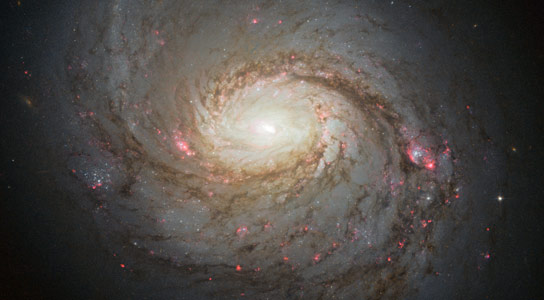NASA’s Hubble Space Telescope views spiral galaxy Messier 77, also known as NGC 1068.
Now, however, it is firmly categorized as a barred spiral galaxy, with loosely wound arms and a relatively small central bulge. It is the closest and brightest example of a particular class of galaxies known as Seyfert galaxies — galaxies that are full of hot, highly ionized gas that glows brightly, emitting intense radiation.
Strong radiation like this is known to come from the heart of Messier 77 — caused by a very active black hole that is around 15 million times the mass of our Sun.
Material is dragged towards this black hole and circles around it, heating up and glowing strongly. This region of a galaxy alone, although comparatively small, can be tens of thousands of times brighter than a typical galaxy.
Continued...
Source
Now, however, it is firmly categorized as a barred spiral galaxy, with loosely wound arms and a relatively small central bulge. It is the closest and brightest example of a particular class of galaxies known as Seyfert galaxies — galaxies that are full of hot, highly ionized gas that glows brightly, emitting intense radiation.
Strong radiation like this is known to come from the heart of Messier 77 — caused by a very active black hole that is around 15 million times the mass of our Sun.
Material is dragged towards this black hole and circles around it, heating up and glowing strongly. This region of a galaxy alone, although comparatively small, can be tens of thousands of times brighter than a typical galaxy.
Continued...
Source






















